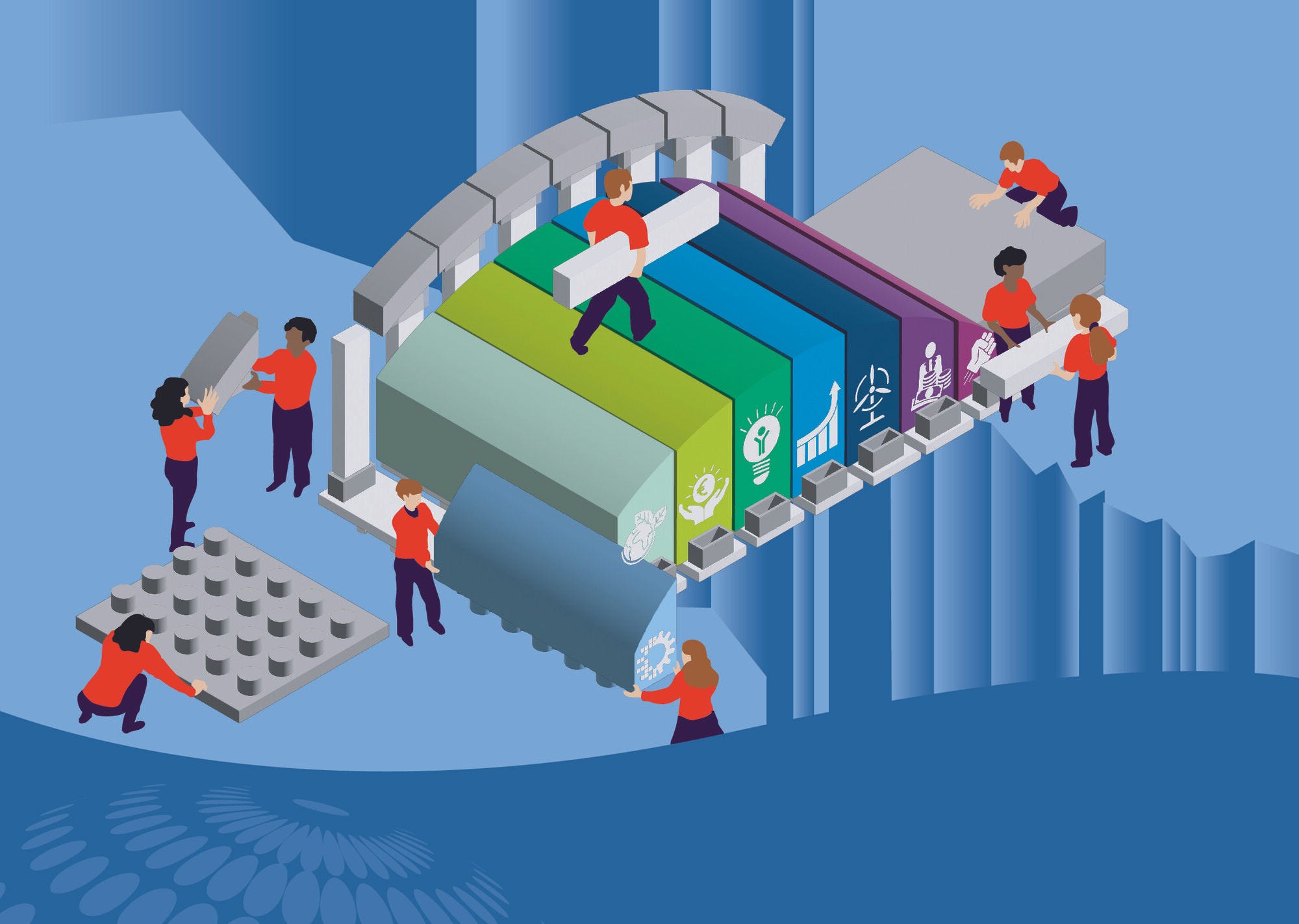The OECD review of Gender Equality in Peru: Towards a Better Sharing of Paid and Unpaid Work is the second of a series focusing on Latin American and the Caribbean countries. It compares gender gaps in labour and educational outcomes in Peru with other countries. Particular attention is put on the uneven distribution of unpaid work, and the extra burden this places on women. It investigates how policies and programmes in Peru can make this distribution more equitable. The first part of the report reviews the evidence on gender gaps and on what causes these, including the role played by attitudes. The second part develops a comprehensive framework to address these challenges, presenting a broad range of options to reduce the unpaid work burden falling on women, and to increase women’s labour income. The final part discusses the impact of the COVID-19 crisis and considers how the policy priorities of the government will have to change to address these. An earlier review in the same series has looked at gender equality policies in Chile (2021).
Gender Equality in Peru

Abstract
Executive Summary
Over the past decades, gender equality in Peru has advanced along several dimensions. Achievements include improved educational attainment at all levels, particularly for women; higher returns to education among women; and their greater labour market inclusion. Close to six out of ten women are employed in Peru, which is higher than in the Latin American comparator countries used for this study – Chile, Colombia and Cost Rica – but lower than the OECD average.
Notwithstanding these achievements, challenges remain. Like in all countries, men and women do not share paid and unpaid work activities equally. Women are less likely to work for pay, and to do so full-time. Instead, they typically spend more hours looking after children and elderly relatives and doing housework. On average Peruvian women spend 24 more hours per week on unpaid tasks than men do and men devote 21 more hours to paid work activities per week than women, which points to a strong gender divide.
Even when they work for pay, Peruvian women tend to be overrepresented in the relatively sizeable informal sector, which creates a barrier that prevents them from moving into more productive, better-paid and better quality jobs. At 75%, the rate of informal employment for women workers is significantly higher in Peru than in Chile, Costa Rica and Colombia, for example. At the same time, female workers are more likely to earn a low income and less likely to advance to management positions. Furthermore, girls are much less likely to study in the more lucrative science, technology, engineering and mathematics (STEM) fields.
Peru has suffered the highest COVID‑19 death rate per head worldwide. This contrasts with the fact that in the immediate aftermath of the pandemic’s outbreak, the international community largely credited Peru for being the first country in Latin America to implement resolute countering actions. Such a significant divergence between efforts displayed and outcomes has unveiled the full extent of pre‑existing economic and social challenges. A key one concerns the difficulties of reconciling paid employment with family responsibilities, with social distancing measures and school closures having led many Peruvian women with young children to abandon the labour market. They also sparked stress and mental health problems and an upsurge of episodes of violence against women. The health, labour and social effects of the COVID‑19 crisis have been stronger among women of indigenous groups and Afro-descendants women.
The OECD review of Gender Equality in Peru puts forward a comprehensive policy strategy to reduce the barriers that stand in the way of a more balanced allocation of time and responsibilities between men and women and to increase the participation of women in the labour market. It also looks at the impact of the COVID‑19 pandemic, how it has exacerbated pre‑existing challenges to greater gender equality in Peru, and suggests policy measures on how to overcome such barriers.
Main recommendations for reducing barriers to sharing paid and unpaid work more equitably
Increase the capacity of childcare services to cover children of low-income families. In particular, gradually expand the number of childcare places in tandem with the increase of the income threshold to qualify for access. The latter measure would meet the need of many working parents whose combined income is either too high to qualify for a place in a public day-care centre, or too low to afford a quality private day-care centre. Develop and encourage dialogue between employers and employees to meet a growing interest towards engaging the private sector in the provision of childcare services.
Improve parental leave rights by complementing the maternity leave – which already meets the international standard established by the ILO – with the establishment of a reserved paternity leave, as a way to encourage the take‑up by fathers. At the same time, strengthen the expansion of parental protection to uncovered categories of workers, by raising the income cut-off for entitlement to the programme Juntos, alongside the level of the benefits provided. Simplify enrolment procedures through decentralised and mobile registration units and paperless registration.
The recent reform of the National Curriculum for Basic Education has the potential to set a strong basis for raising awareness of future generations about the importance of the equal representation of men and women in all aspects of life. To implement the spirit of the new Curriculum: i) foster the recourse to inclusive language, while also achieving a balanced representation of men and women models in textbooks; ii) train teachers to address gender attitudes and stereotypes at school; and iii) engage the supportive role of parents, through information campaigns, workshops and talks.
Reinforce efforts to attract girls into STEM disciplines by expanding teacher training to tackle gender biases in such areas. This could include equipping teachers with appropriate pedagogical tools to help children overcoming anxiety about mathematics and the lack of confidence in their science and mathematics abilities.
Step up ongoing efforts to increase levels of safety and security on public transport, including by reinforcing ad hoc training for transport employees, and delivering prevention campaigns in public transport vehicles and stations.
Main recommendations for making women’s paid work pay more
Ensure access to quality education for all by providing additional support to vulnerable girls and teenage mothers and by rewarding the benefits of completing studies. Raise awareness about the benefits of completing studies by introducing communication and information programmes, such as the pilot programme Decidiendo para un futuro mejor (Deciding for a better future), which was devised by the MineduLAB.
Promote women’s access to leadership positions and achievements in non-traditional careers, with a particular emphasis on: i) the role of business associations and networks in supporting women achievers acting as role models; ii) promoting an academic culture that integrates women faculty members and supports them to excel; and iii) continuing the efforts to strengthen women’s representation in public leadership.
Raise the attractiveness of the formal labour market to female workers, by developing social protection programmes capable of compensating individuals for the contribution losses incurred while working part time, or during times spent out of the labour force caring for dependents – e.g. in the form of pension “top ups” or “care credits”. Promote consultation mechanisms to engage informal female workers in policy design. Foster ongoing efforts to improve the formalisation and labour rights of domestic and care workers.
Support women’s entrepreneurship through developing and improving “bundled” strategies, which combine access to formal saving services and flexible debt repayment conditions with non-financial measures, such as markets and business training, for example, alongside financial education and the acquisition of digital skills.
Responding to the COVID‑19 pandemic
Facilitate access of low-income families – in particular single parents, who are predominantly female – to benefits, as well as to social security programmes, which support families as a whole and allow women return to formal employment.
In anticipation of possible new waves of infections, step-up efforts to prepare firms to use emergency measures against the increase of women’s labour market inactivity and exclusion – e.g. reduction of working hours and recourse to flexible work options, relief for working parents, and the management of redundancy payments related to temporary lay-offs and sick leave.
Ensure that any further closure of education institutions remains as limited as possible and based on an assessment of area specific infection conditions. This is essential to preserve continuity of educational programmes and to help women stay at work or actively searching for a new job.
Improve the efforts to push back on social acceptance of domestic violence by strengthening the integration of services for victims across different spheres. This requires that all relevant public agencies involved, in the domains of health, social services, education, employment and justice, work in a closely co‑ordinated manner so to provide timely access to justice. Step up existing mechanisms to facilitate the reporting of these situations at workplaces, schools and universities, and provide integrated social services for survivors and their children.
More fundamentally, the above measures must be embedded in broader efforts to mainstream gender in government’s responses. In the short term, this means, wherever possible, applying a gender lens to emergency policy measures. In the longer term, it means implementing mechanisms of gender mainstreaming, relying on ready access to gender-disaggregated evidence in all sectors so to promptly asses differential effects on women and men.
In the same series
Related publications
-
 21 November 2024
21 November 2024 -
 Policy paper19 November 2024
Policy paper19 November 2024 -
 10 September 2024
10 September 2024











